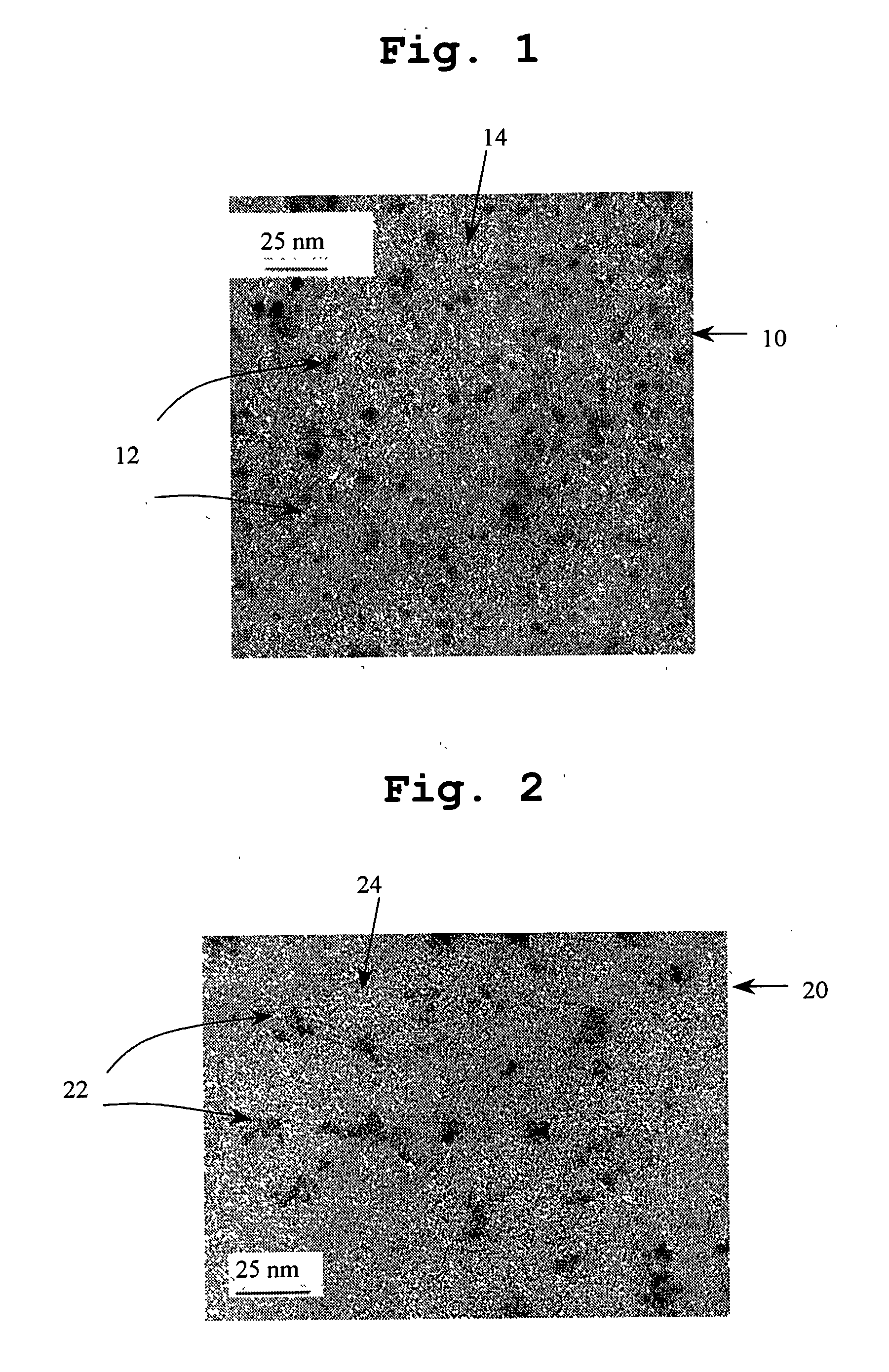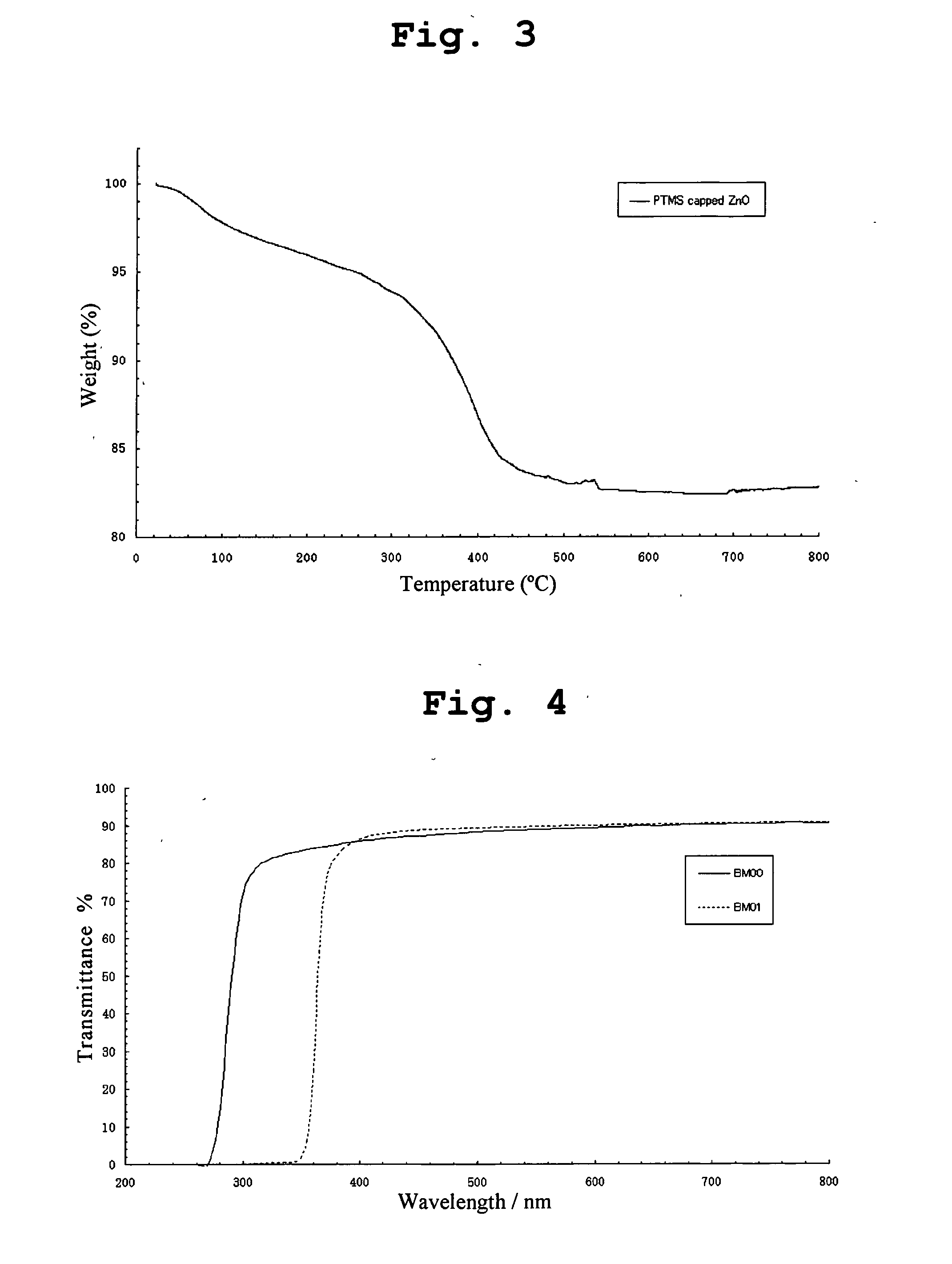Transparent polymer nanocomposites containing nanoparticles and method of making same
a polymer and nanoparticle technology, applied in the field of polymer nanocomposites, can solve the problems of reducing the content of nanoparticles, reducing the quality of surface finish, and reducing the service life of organic uv absorbers such as benzotriazols, and achieving high content of nanoparticles. , the effect of high quality transparency
- Summary
- Abstract
- Description
- Claims
- Application Information
AI Technical Summary
Benefits of technology
Problems solved by technology
Method used
Image
Examples
example 1
Preparation of ZnO / PMMA Nanocomposites
Preparation of Particles
[0066]Solvents and reagents used in this and subsequent examples were of reagent grade and used without further purification. ZnO nanoparticle alcoholic solutions produced by a variety of methods available in the literature may be employed in production of nanoparticles less than 10 nm in diameter. In this example, the method of Bahnemann et al (J. Phys. Chem., 91:3789, (1987)) will be used with modifications. Briefly, 0.439 g (2 mmol) of zinc acetate dihydrate (98%) was dissolved in 160 mL of 2-propanol under stirring at 50° C., after which the solution was further diluted to 1840 mL. 0.16 g (4 mmol) of sodium hydroxide pellets (99.99%) were dissolved in 160 mL of 2-propanol at 50° C., this solution was added to the zinc acetate solution at 0° C. under stirring. The mixture was placed in a water bath that was preheated to 60° C. for 2 hours. The reaction solution was then concentrated by a rotary evaporator at 30˜35° C. ...
example 2
Preparation of ZnO / PSt Nanocomposites
Preparation of Particles
[0069]The same procedure as described in Example 1 was followed.
Preparation of Capping Solution and Capped ZnO
[0070]The same procedure as described in Example 1 was followed except that p-(Trimethylsilyl)phenylmethanethiol (TMSPMT) from Wako Chemicals was used instead of BM.
[0071]A solution of 0.393 g (2 mmole) of TMSPMT in methanol (10 ml) was prepared. The TMSPMT solution was rapidly added to the reaction solution while stirring. The ZnO nanocrystals were capped by TMSPMT and the flocculation of nanocrystals resulted in formation of slight yellow or white precipitates. The precipitate was allowed to settle and then separated from the solution phase by centrifugation. The precipitate collected was redispersed in methanol to form a turbid suspension and centrifuged. This purification procedure was repeated once more. The purified precipitate was dried in a vacuum oven at room temperature for 2 hours to obtain a slightly ye...
example 3
Preparation OF ZnO / PMMA Nanocomposites
Preparation of Particles
[0073]In this example, the method of Li et al as disclosed in US patent publication no. US20050260122 will be used with modifications. Briefly, 8.78 g (0.04 moles) of zinc acetate dihydrate (98%) was dissolved in 200 mL of methanol under stirring at 60° C., after which the solution was allowed to cool to 25° C. An alkali solution was prepared using 4.489 g (0.08) moles of potassium hydroxide pellets (85%), which were dissolved in 800 mL of methanol under stirring and temperature was maintained at 60° C. The zinc acetate dihydrate solution was rapidly poured into the alkali solution while stirring. Solution turbidity may be observed which eventually clears up within an hour to give a transparent solution. The reaction was allowed to continue for 2 hours after which the solution was cooled to 0˜5° C. to halt further nanocrystal growth. The solution thus prepared gives 1 L of 0.04 M ZnO colloidal solution.
Preparation of Capp...
PUM
| Property | Measurement | Unit |
|---|---|---|
| thickness | aaaaa | aaaaa |
| UV cut-off wavelength | aaaaa | aaaaa |
| temperature | aaaaa | aaaaa |
Abstract
Description
Claims
Application Information
 Login to View More
Login to View More - R&D
- Intellectual Property
- Life Sciences
- Materials
- Tech Scout
- Unparalleled Data Quality
- Higher Quality Content
- 60% Fewer Hallucinations
Browse by: Latest US Patents, China's latest patents, Technical Efficacy Thesaurus, Application Domain, Technology Topic, Popular Technical Reports.
© 2025 PatSnap. All rights reserved.Legal|Privacy policy|Modern Slavery Act Transparency Statement|Sitemap|About US| Contact US: help@patsnap.com



